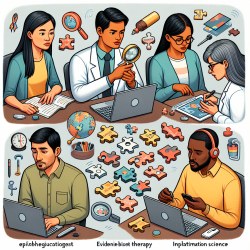In the ever-evolving field of speech therapy and language disorders, the integration of genetic insights into clinical practice remains a frontier ripe with potential. The book "Toward a Genetics of Language," edited by Mabel L. Rice, offers a comprehensive exploration of the genetic underpinnings of language and its disorders. This resource is invaluable for practitioners seeking to deepen their understanding of language development and impairment, presenting a multidisciplinary approach that bridges genetics, linguistics, neuroscience, and more. This blog aims to elucidate key takeaways from the book and suggest practical applications for speech therapists and educators, fostering an environment of continuous professional growth.
At its core, "Toward a Genetics of Language" is structured to demystify the complex relationship between genetics and language. The initial sections provide an accessible introduction to genetics for those unfamiliar with the field, setting the stage for a deeper dive into the genetics of dyslexia and other language disorders. This foundational knowledge is crucial for practitioners, as it empowers them to consider genetic factors when assessing and treating language impairments.
The book further explores linguistic theory and language acquisition, presenting analyses of specific language features like finiteness and Wh-questions. These insights are particularly beneficial for speech therapists, as they underscore the intricate processes underlying language learning and the potential genetic influences on these processes. By integrating these concepts into therapy sessions, practitioners can develop more targeted interventions that address the root causes of language difficulties.
One of the book's strengths lies in its cross-disciplinary perspective, showcasing the necessity of a holistic approach to understanding language disorders. The chapters on language impairment review epidemiological studies and crosslinguistic research, highlighting the diverse manifestations of language disorders across different languages. This global perspective encourages speech therapists to adopt a more inclusive and adaptable approach to therapy, considering the unique linguistic backgrounds of their clients.
Moreover, the book delves into the neurological differences associated with specific language impairment (SLI), reviewing MRI and PET studies that reveal neuroanatomical and functional variances. These findings are pivotal for practitioners, as they offer a biological basis for language disorders that can inform diagnostic and therapeutic strategies. Understanding the neurological aspects of SLI enables therapists to tailor their interventions more precisely, potentially improving outcomes for individuals with language impairments.
Perhaps one of the most compelling sections is the discussion on interactionalism versus innatism in language acquisition. This debate has significant implications for speech therapy, as it touches upon the role of the environment versus genetic predisposition in language development. By engaging with these theories, practitioners can refine their therapeutic philosophies, balancing the influence of innate capabilities and environmental stimulation in their treatment plans.
Throughout the book, the inclusion of commentaries by various authors enriches the discourse, offering diverse perspectives on the genetic basis of language. This format encourages critical thinking and dialogue among practitioners, fostering a community of learning and collaboration. Speech therapists and educators are thus motivated to question and expand their existing knowledge, seeking out further research and professional development opportunities to enhance their practice.
In applying the insights from "Toward a Genetics of Language" to clinical practice, speech therapists can take several actionable steps:
- Enhance assessment protocols to include considerations of genetic factors and neurological findings related to language disorders.
- Incorporate discussions of linguistic theory and language acquisition processes into therapy sessions, making the connection between genetics and language learning more explicit for clients and families.
- Adopt a crosslinguistic perspective in therapy planning, acknowledging the diversity of language impairments and the potential genetic influences on language development across different linguistic backgrounds.
- Engage in continuous professional development, leveraging the multidisciplinary insights from the book to stay abreast of the latest research in genetics, linguistics, and neuroscience as they relate to speech therapy.
- Create a collaborative network with other professionals, including geneticists and neuroscientists, to facilitate a comprehensive approach to diagnosing and treating language disorders.
"Toward a Genetics of Language" serves as a catalyst for speech therapists and educators to explore the genetic dimensions of language and its disorders. By integrating the research and theories presented in this book into practice, practitioners can enhance their therapeutic strategies, ultimately improving the support they provide to individuals with language impairments.
For those interested in delving deeper into the genetic basis of language and its implications for speech therapy, reading the original research is highly recommended. To access "Toward a Genetics of Language," please follow this link.










